by Calculated Risk on 1/09/2017 08:11:00 AM
Monday, January 09, 2017
Black Knight November Mortgage Monitor
Black Knight Financial Services (BKFS) released their Mortgage Monitor report for November today. According to BKFS, 4.46% of mortgages were delinquent in November, down from 4.92% in November 2015. BKFS also reported that 0.98% of mortgages were in the foreclosure process, down from 1.38% a year ago.
This gives a total of 5.44% delinquent or in foreclosure.
Press Release: Black Knight’s Mortgage Monitor: 2.2 Million Homeowners in Negative Equity, Fewest Since Early 2007; $4.6 Trillion in Tappable Equity is Within Six Percent of Peak
Today, the Data & Analytics division of Black Knight Financial Services, Inc. (NYSE: BKFS) released its latest Mortgage Monitor Report, based on data as of the end of November 2016. In the first three quarters of 2016, as home prices continued to appreciate, one million previously underwater homeowners returned to positive equity positions, while tappable equity totals continued to rise. This month, Black Knight looked at the extent and impact of these changes on the market. As Black Knight Data & Analytics Executive Vice President Ben Graboske explained, there is a distinct geographical component at work, with regard to both the negative and tappable equity sides of the equation.
“The negative equity situation has improved substantially since the height of the great recession,” said Graboske. “There are now just 2.2 million homeowners left in negative equity positions, a full one million fewer than at the start of 2016. Whereas negative home equity was once a widespread national problem – with roughly 30 percent of all homeowners being underwater on their mortgages at the end of 2010 – it has now become much more of a localized issue. By and large, the majority of states have negative equity rates below the national average of 4.4 percent. There are, though, some pockets where homeowners continue to struggle. Three states in particular stand out: Nevada, Missouri and New Jersey, all of which have negative equity rates more than twice the national average."
emphasis added
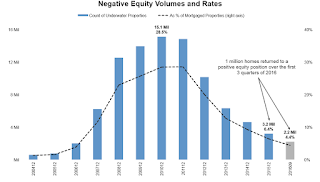 Click on graph for larger image.
Click on graph for larger image.This graph from Black Knight shows their estimate of the number and percent of loans with negative equity.
From Black Knight:
• Only 2.2 million (4.4 percent) mortgage holders remain underwater on their homes, a decline of one million since the beginning of 2016
• Whereas negative equity was once a widespread national problem – with nearly 30 percent of all homeowners being underwater on their mortgages at the end of 2010 – it has now become much more of a localized issue
• Lower priced homes – those in the bottom 20 percent of prices in their communities – are nine times more likely to be underwater than those in the top 20 percent
• The negative equity rate for borrowers living in the bottom 20 percent of their metro area by price is 11.5 percent, compared to just 1.3 percent for those in the top 20 percent of the market
 This graph from Black Knight shows their estimate of tappable equity:
This graph from Black Knight shows their estimate of tappable equity:From Black Knight:
• There are now 39 million borrowers with tappable equity in their homes, meaning they have current combined loan-to-value (CLTV) ratios of less than 80 percentThere is much more in the mortgage monitor.
• These borrowers have a total of $4.6 trillion in available, lendable equity—an average of about $180,000 per borrower—making for the highest market total and highest average per borrower since 2006
• Total tappable equity grew by $500 billion in just the first three quarters of 2016
• We are now within about six percent of the peak in lendable/tappable equity seen back in late 2005/early 2006
Sunday, January 08, 2017
Sunday Night Futures
by Calculated Risk on 1/08/2017 08:04:00 PM
Weekend:
• Schedule for Week of Jan 8, 2017
• Question #6 for 2017: Will the Fed raise rates in 2017, and if so, by how much?
Monday:
• At 10:00 AM ET, The Fed will release the monthly Labor Market Conditions Index (LMCI).
• At 3:00 PM, Consumer credit from the Federal Reserve. The consensus is for a $18.5 billion increase in credit.
From CNBC: Pre-Market Data and Bloomberg futures: S&P futures are up 2, and DOW futures are up 24 (fair value).
Oil prices were up over the last week with WTI futures at $53.81 per barrel and Brent at $56.97 per barrel. A year ago, WTI was at $33, and Brent was at $32 - so oil prices are up sharply year-over-year.
Here is a graph from Gasbuddy.com for nationwide gasoline prices. Nationally prices are at $2.37 per gallon - a year ago prices were at $2.00 per gallon - so gasoline prices are up almost 40 cents a gallon year-over-year.
Question #6 for 2017: Will the Fed raise rates in 2017, and if so, by how much?
by Calculated Risk on 1/08/2017 12:20:00 PM
Last week I posted some questions for 2017: Ten Economic Questions for 2017. I'll try to add some thoughts, and maybe some predictions for each question.
6) Monetary Policy: The Fed raised rates this month, and now the question is how much will the Fed raise rates in 2017? The market is pricing in three 25 bps rate hikes in 2017, and most analysts expect two to three hikes in 2017. Will the Fed raise rates in 2017, and if so, by how much?
For years I made fun of those predicting an imminent Fed Funds rate increase. Based on high unemployment and low inflation, I argued it would be a "long time" before the first rate hike. A long time passed ... and in 2015 I finally argued a rate hike was likely (although I thought we'd see more than one in 2015). The Fed raised rates in December 2015, and then once again in December 2016.
Currently the the target range for the federal funds rate is 1/2 to 3/4 percent.
As of December, the FOMC members see the following number of rate hikes in 2017:
| 25bp Rate Hikes in 2017 | FOMC Members |
|---|---|
| One | 2 |
| Two | 4 |
| Three | 6 |
| Four | 3 |
| More than Four | 2 |
Analysts are being cautious on forecasting rate hikes, probably because they forecasted too many hikes over the last few years. However, as the economy approaches full employment, and with the possibility of fiscal stimulus in 2017, it is possible that inflation will pick up a little - and, if so, the Fed could hike more than expected.
Analysts at Merrill Lynch recently wrote:
We expect the Fed to hike once in 2017, but the risks are to the upside. Once fiscal stimulus kicks in, we expect the Fed to hike faster – we forecast 3 hikes in 2018.Tim Duy noted Friday: Solid Employment Report Keeps Fed On Track
The labor market finished out the year on a solid note. Solid, not spectacular, and largely consistent with the Fed's expectations. Consequently, the final employment report for 2016 should not impact the Fed's median forecast for 75bp of rate hikes in 2017.The number of hikes depends on the economic outlook and inflation. There are significant uncertainities concerning fiscal policy, and some of the proposals could boost economic growth (as an example, if there is a real infrastructure spending program), and some could impede growth (like a significant trade dispute).
...
The economy is now at a point where a sudden boost in activity would prompt the Fed to accelerate the pace of rate increases. This employment report, however, suggests this isn't happening just yet.
...
Bottom Line: A solid report largely consistent with expectations among monetary policymakers. Hence it should have little impact on interest rate forecasts for the coming year. But watch out for upside risks to the outlook; the economy gained some traction in the final months of 2016. It is reasonable to believe that traction will hold in 2017.
My current guess is the Fed will hike twice in 2017.
Here are the Ten Economic Questions for 2017 and a few predictions:
• Question #1 for 2017: What about fiscal and regulatory policy in 2017?
• Question #2 for 2017: How much will the economy grow in 2017?
• Question #3 for 2017: Will job creation slow further in 2017?
• Question #4 for 2017: What will the unemployment rate be in December 2017?
• Question #5 for 2017: Will the core inflation rate rise in 2017? Will too much inflation be a concern in 2017?
• Question #6 for 2017: Will the Fed raise rates in 2017, and if so, by how much?
• Question #7 for 2017: How much will wages increase in 2017?
• Question #8 for 2017: How much will Residential Investment increase?
• Question #9 for 2017: What will happen with house prices in 2017?
• Question #10 for 2017: Will housing inventory increase or decrease in 2017?
Saturday, January 07, 2017
Schedule for Week of Jan 8th
by Calculated Risk on 1/07/2017 08:11:00 AM
This will be a light week for economic data.
The key economic report this week is December Retail Sales.
10:00 AM ET: The Fed will release the monthly Labor Market Conditions Index (LMCI).
3:00 PM: Consumer credit from the Federal Reserve. The consensus is for a $18.5 billion increase in credit.
6:00 AM ET: NFIB Small Business Optimism Index for December.
 10:00 AM: Job Openings and Labor Turnover Survey for November from the BLS.
10:00 AM: Job Openings and Labor Turnover Survey for November from the BLS. This graph shows job openings (yellow line), hires (purple), Layoff, Discharges and other (red column), and Quits (light blue column) from the JOLTS.
Jobs openings decreased in October to 5.534 million from 5.631 million in September.
The number of job openings (yellow) were up 2% year-over-year, and Quits were up 7% year-over-year.
7:00 AM ET: The Mortgage Bankers Association (MBA) will release the results for the mortgage purchase applications index.
8:30 AM ET: The initial weekly unemployment claims report will be released. The consensus is for 255 thousand initial claims, up from 235 thousand the previous week.
7:00 PM, Conversation with the Chair: A Teacher Town Hall Meeting, Chair Janet Yellen will address educators in Washington, D.C., and nationwide via webcast.
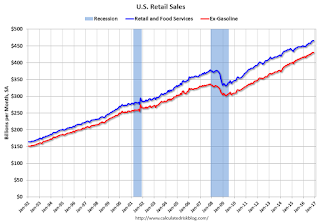 8:30 AM ET: Retail sales for December will be released. The consensus is for 0.7% increase in retail sales in December.
8:30 AM ET: Retail sales for December will be released. The consensus is for 0.7% increase in retail sales in December.This graph shows retail sales since 1992 through November 2016.
8:30 AM: The Producer Price Index for December from the BLS. The consensus is for a 0.3% increase in prices, and a 0.1% increase in core PPI.
10:00 AM: Manufacturing and Trade: Inventories and Sales (business inventories) report for November. The consensus is for a 0.6% increase in inventories.
10:00 AM: University of Michigan's Consumer sentiment index (preliminary for January). The consensus is for a reading of 98.6, up from 98.2 in November.
Friday, January 06, 2017
Las Vegas Real Estate in December: Sales up 3.4% YoY, Inventory down Sharply
by Calculated Risk on 1/06/2017 05:55:00 PM
This is a key distressed market to follow since Las Vegas has seen the largest price decline of any of the Case-Shiller composite 20 cities.
The Greater Las Vegas Association of Realtors reported Southern Nevada Home Sales Rose in 2016, Including During December, GLVAR Housing Statistics for December 2016
The Greater Las Vegas Association of REALTORS® (GLVAR) reported Friday that more existing homes were sold in Southern Nevada in 2016 than in 2015, even with a tight housing supply and rising home prices.1) Overall sales were up 3.4% year-over-year.
...
The total number of existing local homes, condos and townhomes sold in December was 3,402, up from 3,290 in December 2015. According to GLVAR, a total of 41,720 such properties were sold in 2016. That was more than the 38,577 properties sold during 2015. It was also more than in 2014, but fewer than during each of the previous five years.
...
By the end of December, GLVAR reported 5,951 single-family homes listed for sale without any sort of offer. That’s down 17.6 percent from one year ago. For condos and townhomes, the 910 properties listed without offers in December represented a 56.5 percent decrease from one year ago.
emphasis added
2) Active inventory (single-family and condos) is down sharply from a year ago (A very sharp decline in condo inventory).
Reis: Regional Mall Vacancy Rate decreased in Q3 2016, Strip Mall Vacancy Rate increased
by Calculated Risk on 1/06/2017 03:00:00 PM
Reis reported that the vacancy rate for regional malls was 7.8% in Q4 2016, unchanged from Q3, and unchanged from 7.8% in Q4 2015. This is down from a cycle peak of 9.4% in Q3 2011.
For Neighborhood and Community malls (strip malls), the vacancy rate was 9.9% in Q4, unchanged from Q3, and down from 10.0% in Q4 2015. For strip malls, the vacancy rate peaked at 11.1% in Q3 2011.
Comments from Reis Economist Barbara Byrne Denham :
Although net absorption was positive, the U.S. vacancy rate for neighborhood and community shopping centers was flat at 9.9%. The national retail average asking rent grew 0.4% for the quarter, as was the effective rent growth rate which was in line with previous quarters. For the year, asking rents increased 1.8% while effective rents increased 1.9%.
The statistics for Malls tell a similar story: a flat vacancy rate and very little change in asking or effective rents. The regional mall vacancy rate was 7.8% -- no change from last quarter or from the fourth quarter of 2015. Asking rents increased 0.4% for the quarter and 2.0% for the year.
...
In short, the fourth quarter statistics show that the growth in e-commerce that has led to scores of store closures across the U.S. is truly starting to impact many retail property markets in a meaningful way. Evidence of this came earlier this week when both Macy's and Sears/Kmart announced more store closures.
emphasis added
 Click on graph for larger image.
Click on graph for larger image.This graph shows the strip mall vacancy rate starting in 1980 (prior to 2000 the data is annual). The regional mall data starts in 2000. Back in the '80s, there was overbuilding in the mall sector even as the vacancy rate was rising. This was due to the very loose commercial lending that led to the S&L crisis.
In the mid-'00s, mall investment picked up as mall builders followed the "roof tops" of the residential boom (more loose lending). This led to the vacancy rate moving higher even before the recession started. Then there was a sharp increase in the vacancy rate during the recession and financial crisis.
Currently, both the strip mall and regional mall vacancy rates are mostly moving sideways at an elevated level.
Mall vacancy data courtesy of Reis.
Trade Deficit at $45.2 Billion in November
by Calculated Risk on 1/06/2017 11:58:00 AM
From the Department of Commerce reported:
The U.S. Census Bureau and the U.S. Bureau of Economic Analysis, through the Department of Commerce, announced today that the goods and services deficit was $45.2 billion in November, up $2.9 billion from $42.4 billion in October, revised. November exports were $185.8 billion, $0.4 billion less than October exports. November imports were $231.1 billion, $2.4 billion more than October imports.The trade deficit was larger than the consensus forecast.
The first graph shows the monthly U.S. exports and imports in dollars through November 2016.
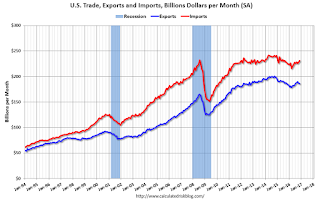 Click on graph for larger image.
Click on graph for larger image.Imports increased and exports decreased in October.
Exports are 12% above the pre-recession peak and up 1% compared to November 2015; imports are up 3% compared to November 2015.
It appears trade might be picking up a little.
The second graph shows the U.S. trade deficit, with and without petroleum.
 The blue line is the total deficit, and the black line is the petroleum deficit, and the red line is the trade deficit ex-petroleum products.
The blue line is the total deficit, and the black line is the petroleum deficit, and the red line is the trade deficit ex-petroleum products.Oil imports averaged $40.82 in November, up from $40.01 in October, and down from $39.19 in November 2015. The petroleum deficit has generally been declining and is the major reason the overall deficit has declined a little since early 2012.
The trade deficit with China decreased to $30.5 billion in November, from $31.3 billion in November 2015. The deficit with China is a substantial portion of the overall deficit, but the deficit with China has been declining.
Comments: Solid December Employment Report, Pickup in Wage Growth
by Calculated Risk on 1/06/2017 09:57:00 AM
The headline jobs number was below expectations, but, including the combined upward revisions to the previous two months, this was a solid report.
Earlier: December Employment Report: 156,000 Jobs, 4.7% Unemployment Rate
Job growth has averaged 180,000 per month this year.
In December, the year-over-year change was 2.16 million jobs.
A key positive was the increase in hourly earnings. This is a noisy series, and the trend is clearly up.
Average Hourly Earnings

This graph is based on “Average Hourly Earnings” from the Current Employment Statistics (CES) (aka "Establishment") monthly employment report. Note: There are also two quarterly sources for earnings data: 1) “Hourly Compensation,” from the BLS’s Productivity and Costs; and 2) the Employment Cost Index which includes wage/salary and benefit compensation.
The graph shows the nominal year-over-year change in "Average Hourly Earnings" for all private employees. Nominal wage growth was at 2.9% YoY in December.
Seasonal Retail Hiring
According to the BLS employment report, retailers hired seasonal workers at a lower pace than the last few years.

This graph really shows the collapse in retail hiring in 2008. Since then seasonal hiring has increased back close to more normal levels. Note: I expect the long term trend will be down with more and more internet holiday shopping.
Retailers hired 673 thousand workers (NSA) net in October, November and December, this is down from just over 739 thousand for the same period over the last several years. Note: this is NSA (Not Seasonally Adjusted).
This suggests retailers were a little cautious about the holiday season. Or maybe retailers had trouble finding seasonal hires.
Employment-Population Ratio, 25 to 54 years old
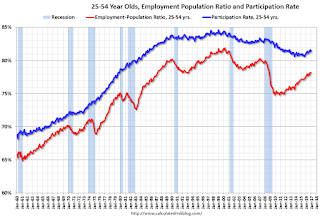
In the earlier period the participation rate for this group was trending up as women joined the labor force. Since the early '90s, the participation rate moved more sideways, with a downward drift starting around '00 - and with ups and downs related to the business cycle.
The 25 to 54 participation rate increased in December to 81.5%, and the 25 to 54 employment population ratio was unchanged at 78.2%.
The participation rate has been trending down for this group since the late '90s, however, with more younger workers (and fewer older workers), the participation rate might move up some more.
Part Time for Economic Reasons
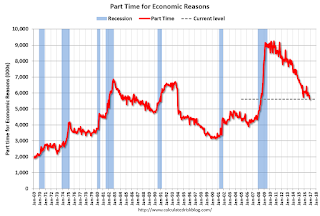
The number of persons employed part time for economic reasons (also referred to as involuntary part-time workers), at 5.6 million, was essentially unchanged in December but was down by 459,000 over the year. These individuals, who would have preferred full-time employment, were working part time because their hours had been cut back or because they were unable to find a full-time job.The number of persons working part time for economic reasons declined in December, and this is the lowest level since June 2008. This level suggests slack still in the labor market.
These workers are included in the alternate measure of labor underutilization (U-6) that declined to 9.2% in December. This is the lowest level for U-6 since April 2008.
Unemployed over 26 Weeks
 This graph shows the number of workers unemployed for 27 weeks or more.
This graph shows the number of workers unemployed for 27 weeks or more. According to the BLS, there are 1.831 million workers who have been unemployed for more than 26 weeks and still want a job. This was down from 1.856 million in November.
This is trending down, and is at the lowest level since July 2008.
Overall this was another solid report.
December Employment Report: 156,000 Jobs, 4.7% Unemployment Rate
by Calculated Risk on 1/06/2017 08:49:00 AM
From the BLS:
Total nonfarm payroll employment rose by 156,000 in December, and the unemployment rate was little changed at 4.7 percent, the U.S. Bureau of Labor Statistics reported today. Job growth occurred in health care and social assistance.
...
The change in total nonfarm payroll employment for October was revised down from +142,000 to +135,000, and the change for November was revised up from +178,000 to +204,000. With these revisions, employment gains in October and November were 19,000 higher than previously reported.
...
In December, average hourly earnings for all employees on private nonfarm payrolls increased by 10 cents to $26.00, after edging down by 2 cents in November. Over the year, average hourly earnings have risen by 2.9 percent.
emphasis added
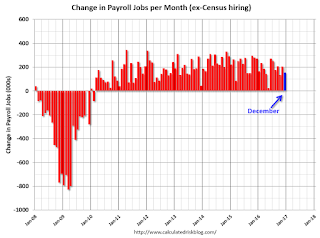 Click on graph for larger image.
Click on graph for larger image.The first graph shows the monthly change in payroll jobs, ex-Census (meaning the impact of the decennial Census temporary hires and layoffs is removed - mostly in 2010 - to show the underlying payroll changes).
Total payrolls increased by 156 thousand in December (private payrolls increased 144 thousand).
Payrolls for October and November were revised up by a combined 19 thousand.
 This graph shows the year-over-year change in total non-farm employment since 1968.
This graph shows the year-over-year change in total non-farm employment since 1968.In December, the year-over-year change was 2.16 million jobs. This has been moving down, but still a solid year-over-year gain.
The third graph shows the employment population ratio and the participation rate.
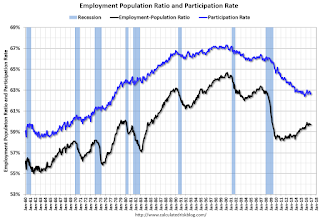 The Labor Force Participation Rate increased in December to 62.7%. This is the percentage of the working age population in the labor force. A large portion of the recent decline in the participation rate is due to demographics.
The Labor Force Participation Rate increased in December to 62.7%. This is the percentage of the working age population in the labor force. A large portion of the recent decline in the participation rate is due to demographics. The Employment-Population ratio was unchanged at 59.7% (black line).
I'll post the 25 to 54 age group employment-population ratio graph later.
 The fourth graph shows the unemployment rate.
The fourth graph shows the unemployment rate. The unemployment rate increased in December to 4.7%.
This was below expectations of 175,000 jobs, however the previous two months were revised up. And there was a pickup in wage growth. Another solid report.
I'll have much more later ...
Thursday, January 05, 2017
Goldman's December NFP Preview
by Calculated Risk on 1/05/2017 05:54:00 PM
A few excerpts from Goldman Sachs' December Payroll Preview by economist Spencer Hill:
We forecast that nonfarm payroll employment increased 180k in December ... Our forecast for steady payroll gains reflects encouraging labor market surveys overall, as well as our expectation of above-trend growth in the transportation industry related to strong online holiday shopping.The December employment report will be released tomorrow, and the consensus is for an increase of 175,000 non-farm payroll jobs in November, and for the unemployment rate to increase to 4.7%.
We expect a one-tenth rise in the U3 unemployment rate to 4.7%, recouping part of its 0.3pp decline last month (to 4.64% unrounded). Average hourly earnings likely rebounded 0.3% after a 0.1% decline in November, boosted by more favorable calendar effects, with the year-over-year rate likely to accelerate 0.3pp to 2.8%, matching its post-crisis high.
...
Tomorrow’s employment report will be accompanied by the annual revision to the household survey, with potential revisions to the last 5 years of seasonally adjusted household data. ... The revisions to the household survey accompanying the December report are usually minor, and last year’s revisions did not result in a change to any of the monthly unemployment rates for 2015.
emphasis added


